How to Evaluate and Manage Employee Performance Effectively
Set clear goals and assess employee performance and compensation effectively. Use multiple appraisal methods and leverage tech for real-time feedback. Click to improve your evaluation strategy now!
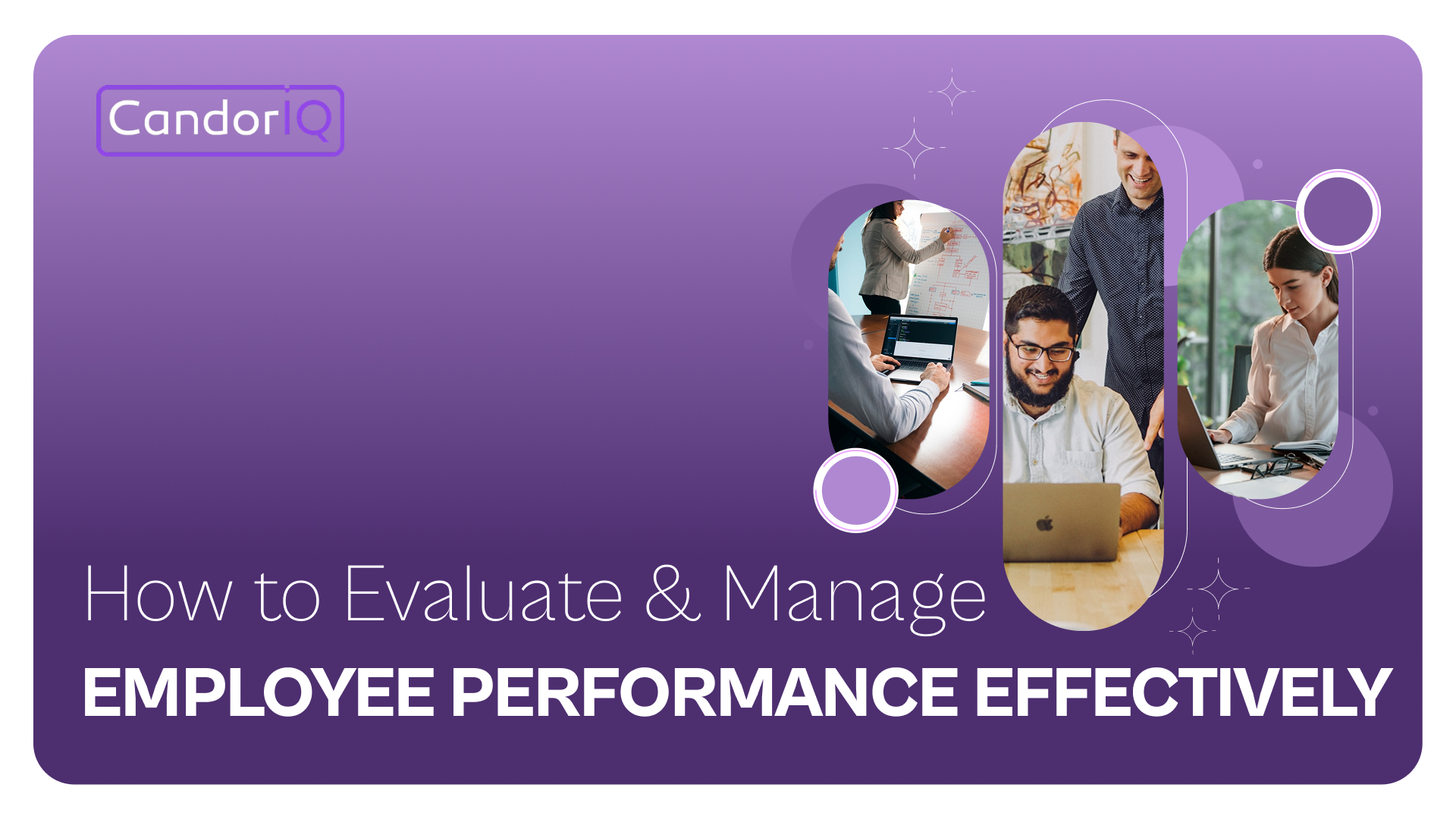
Imagine trying to steer a ship through fog with no compass and no visibility, only vague recollections of where you think you were last quarter. That’s what traditional performance reviews feel like for most high-growth teams today.
When companies are scaling rapidly, managing hybrid teams across time zones, and running lean HR and finance functions, waiting 12 months to talk about goals, growth, or compensation doesn’t cut it anymore.
Employees want clarity on their impact, their growth path, and what it takes to level up. Leaders, on the other hand, need structured, scalable systems that help them connect performance to business decisions without relying on scattered notes or spreadsheet folklore.
So how do you bring structure without killing speed? In this guide, we’ll walk through how to replace outdated review cycles with dynamic, real-time systems, connect performance data to promotions, raises, and retention, empower HR, Finance, and People leaders to collaborate better, and use tools that reduce subjectivity and increase visibility.
Whether you’re a CPO trying to drive fairness, a CFO planning headcount ROI, or a Recruiting Manager mapping internal mobility, this blog gives you a practical guide to manage performance with clarity and impact.
TLDR: What You’ll Walk Away With
- Annual reviews are too slow and vague for today’s fast-moving, distributed teams
- Continuous feedback tied to clear goals creates more accountability and engagement
- Linking performance directly to compensation and promotions increases transparency and trust
- Centralized tools help HR, Finance, and leadership make faster, fairer, data-backed decisions
- A structured performance system supports both individual growth and company scaling
Why Traditional Reviews Fall Short for Fast-Scaling Teams
Traditional models fall short for today’s dynamic teams. Annual reviews were built for slower, in-office environments. Fast-scaling companies with distributed teams and lean HR functions need more flexible, real-time strategies.
Here’s why change is necessary:
- Static reviews can't keep up with evolving roles: In fast-paced environments, roles change faster than yearly cycles can track. Employees need real-time alignment with shifting business goals.
- Remote work limits informal feedback: Without daily in-person interactions, performance signals can get lost. Managers need better systems for visibility and feedback.
- Compensation and growth are now tied to data: As equity, bonuses, and promotions are linked to performance metrics, outdated review processes risk bias and misalignment.
- Employees want clarity and ownership: People want to know how they’re doing, what success looks like, and how they can grow without waiting for an annual meeting.
Modern performance management is not about replacing the review. It’s about replacing delay with data, rigidity with responsiveness, and opinions with shared outcomes.
What Modern Performance Management Looks Like
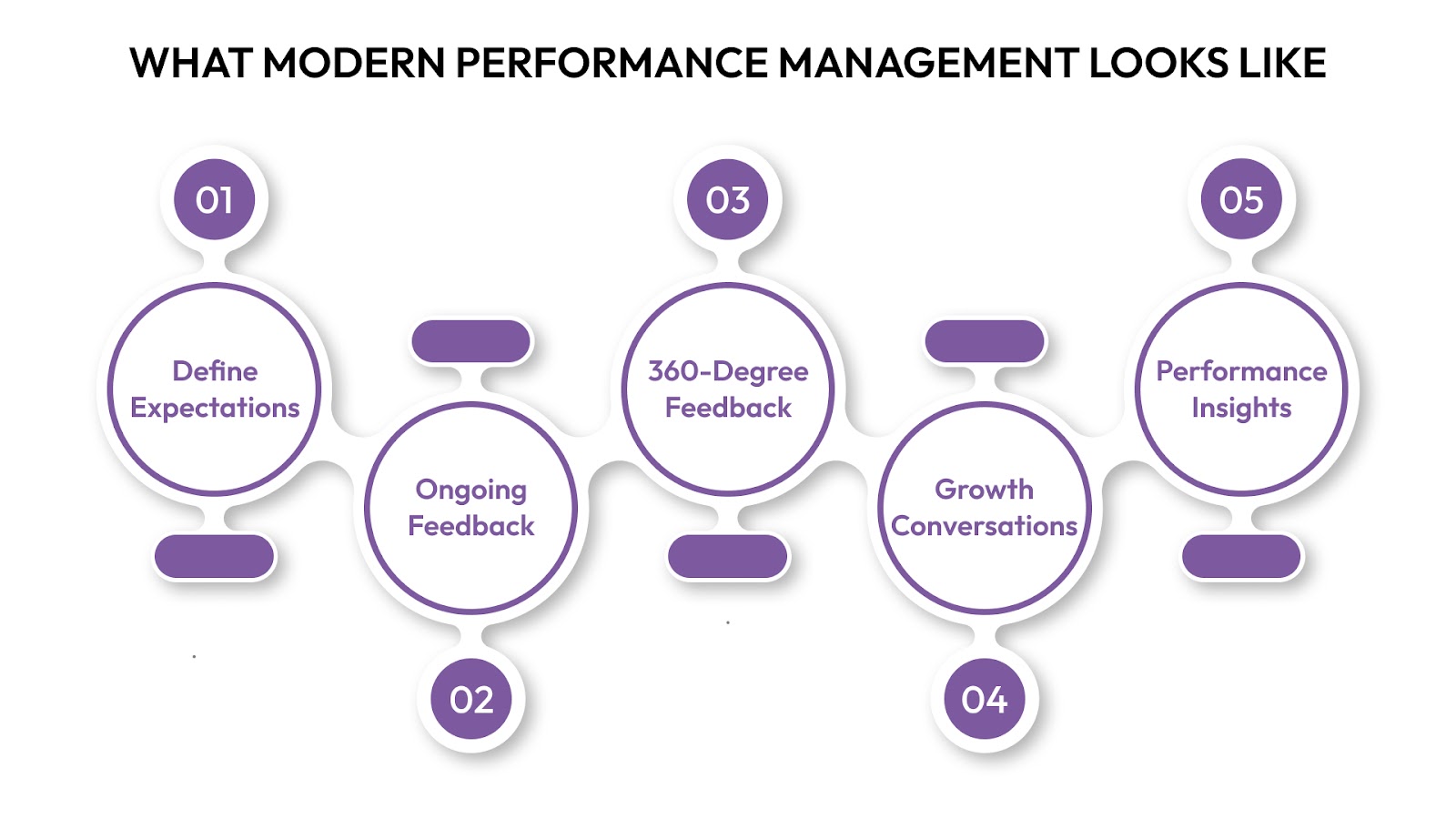
Effective performance management today combines clarity, continuous feedback, and actionable data. It’s not a one-time event but an ongoing system that aligns individual growth with business outcomes.
Here are the core elements:
- Clear Role Expectations and Goals: Define what success looks like for each role using measurable KPIs or OKRs. Avoid vague descriptions and instead tie goals directly to business outcomes.
- Regular Check-Ins and Two-Way Feedback: Move from annual reviews to monthly or quarterly check-ins. Use these to course-correct, recognize wins, and understand employee blockers.
- 360-Degree Feedback: Incorporate feedback from peers, cross-functional teammates, and direct reports to remove bias and give a fuller view of performance.
- Development-Focused Conversations: Shift the focus from just evaluation to growth. Discuss what the employee needs to succeed in current and future roles.
- Performance Data and Dashboards: Use tools that track progress on goals, engagement, and peer feedback in one place. Visibility into patterns supports fairer and faster decisions.
Modern systems give HR and business leaders the ability to act early, reward fairly, and identify high-potential talent without relying solely on manager memory or spreadsheets.
Linking Performance to Compensation and Promotions
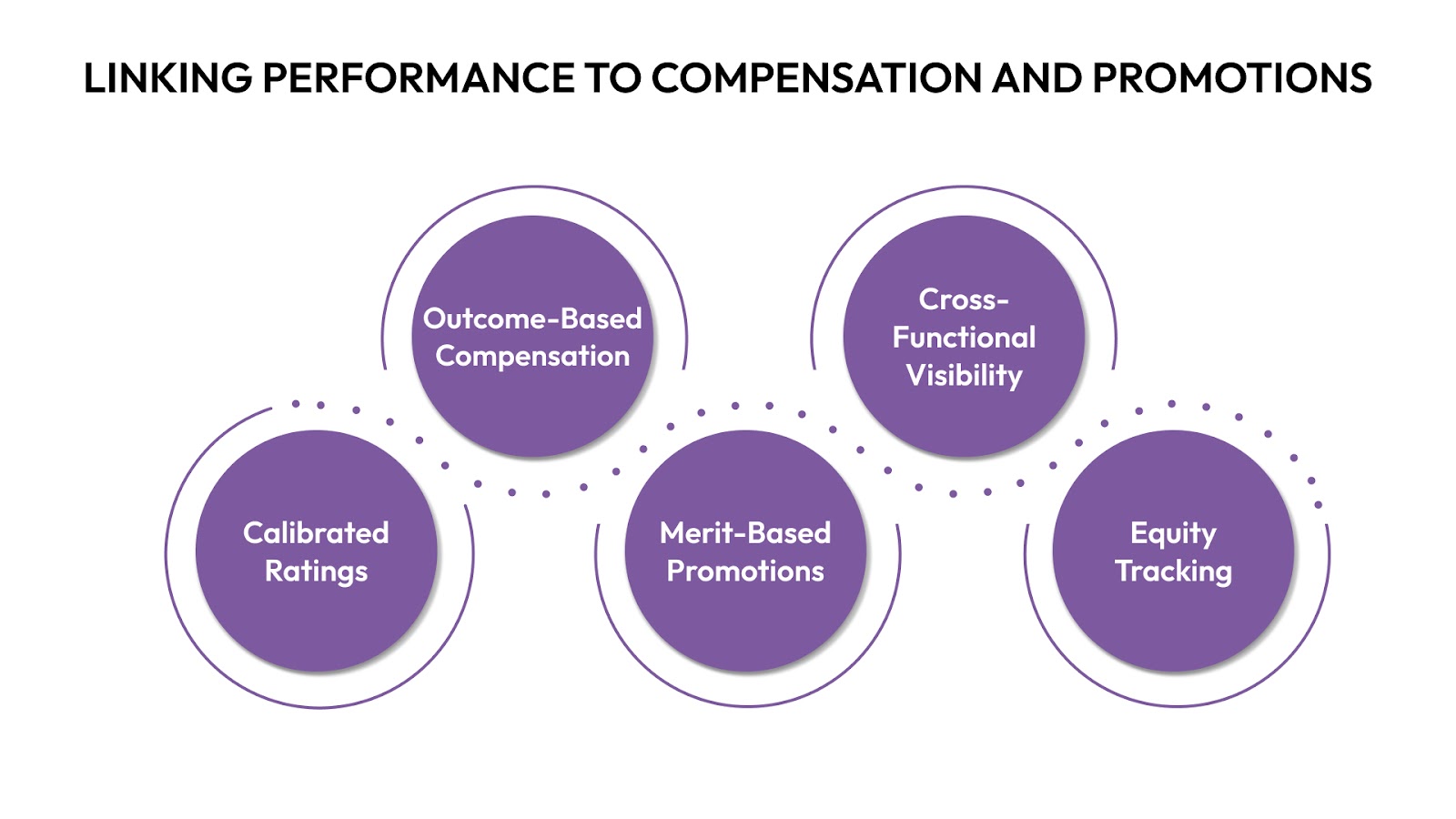
Performance management doesn’t end with feedback. It directly informs how employees are rewarded, promoted, and retained. Without a clear link between performance and compensation decisions, trust erodes and top performers lose motivation.
Here’s how to establish a transparent and consistent link:
- Use Calibrated Performance Ratings: Standardize performance ratings across departments to ensure fairness. Use a clear rubric that avoids bias and allows leadership to differentiate between low, medium, and high performers.
- Tie Compensation to Business Outcomes: Link bonuses, raises, or equity grants to measurable performance outcomes. This reinforces accountability and creates a culture where impact is rewarded, not just tenure.
- Promotions Based on Skills and Outcomes: Move beyond subjective manager nominations. Define promotion criteria using performance data, skill progression, and cross-functional impact to ensure equitable advancement.
- Enable Visibility Across HR and Finance: Use centralized systems that connect performance reviews to compensation cycles and budgeting. This reduces manual coordination and helps both teams plan proactively.
- Track Equity in Pay and Growth: Analyze promotion and compensation trends by department, gender, and location to catch disparities early. Fair performance recognition supports diversity and inclusion goals.

How platforms like CandorIQ support reward planning
Scenario modeling tools help HR and finance teams forecast the financial impact of different compensation structures before rollout. You can simulate outcomes based on team performance, budget constraints, and equity allocation strategies. This ensures decisions are consistent, fair, and within budget.
Want to model reward scenarios before committing to changes? CandorIQ lets you simulate outcomes across performance tiers and budget constraints with zero guesswork.
By aligning performance with compensation and growth, companies create an environment where employees understand how their efforts translate into tangible outcomes and career advancement.
Who Owns What? Roles Across HR, Finance, and People Managers
Effective performance management is not the sole responsibility of HR. It requires coordination across HR, Finance, and line managers to ensure fairness, accuracy, and alignment with business goals.
Here’s what each function contributes:
- HR Teams: Build the Framework
HR defines the process, designs feedback tools, and ensures consistency across the organization. They drive adoption, provide training, and monitor for bias or inconsistencies in how reviews are conducted.
- Managers: Drive Day-to-Day Execution
Managers give regular feedback, guide development plans, and assess performance against objectives. They serve as the primary link between the strategy set by leadership and execution by teams.
- Finance: Ensure Budget Alignment and Reward Accuracy
Finance teams translate performance outcomes into compensation decisions. They help model salary increases, bonuses, and equity grants based on budget availability and reward benchmarks.
- Shared Responsibility: Calibration and Communication
All three groups must align during review cycles to calibrate performance ratings, set compensation thresholds, and communicate outcomes clearly to employees.
- Use of Unified Tools for Collaboration
A centralized platform that offers shared visibility across HR, Finance, and managers simplifies workflows and improves data accuracy. This is especially critical for fast-scaling teams where misalignment can lead to inconsistent rewards and disengagement.
When these functions work in sync, performance management becomes a strategic lever that supports both employee development and business outcomes.
Looking for a shared system across HR, Finance, and People teams? CandorIQ gives all stakeholders one place to plan, review, and align.
How to Track and Improve Performance Over Time
Performance management should not stop after the review cycle ends. Continuous tracking and iteration help companies refine their approach and ensure long-term impact.
Key Metrics to Monitor
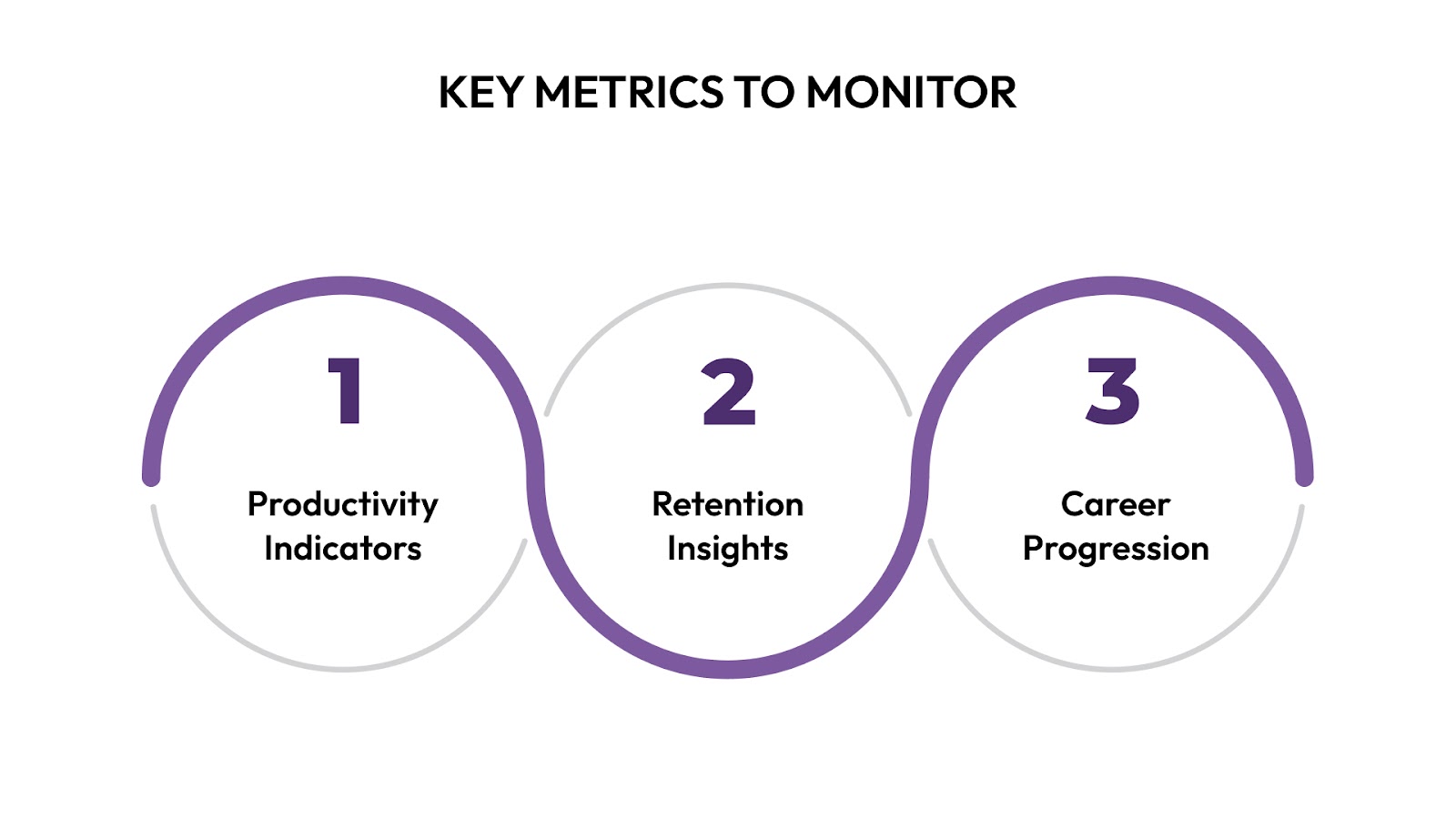
- Engagement and Productivity Indicators: Track participation in feedback cycles, goal completion rates, and manager-employee 1:1 frequency. These signals reveal whether the process is actually driving behavioral change and focus.
- Retention by Performance Tier: Analyze turnover trends by performance ratings. If top performers are leaving more than others, it may signal a lack of recognition or opportunity.
- Promotion Velocity and Internal Mobility: Measure how long it takes for high performers to move up or across functions. Stagnation often leads to disengagement, while well-paced mobility boosts motivation and talent retention.
Tools to Support Performance Tracking
Platforms like CandorIQ help companies:
- Visualize performance trends across teams, roles, and locations
- Connect review outcomes to compensation, promotions, and turnover
- Plan talent movement and budget impact using real-time analytics
- Identify gaps in fairness, rating consistency, or review participation
When performance data is centralized and easy to access, HR and leadership teams can make better decisions about workforce planning, rewards, and development investments.
Where Performance Management Often Goes Off Track
Even with the best intentions, performance management efforts can lose effectiveness when certain structural or strategic missteps occur. Here are some pitfalls to watch for:
- Relying on generic tools not built for performance evaluation: Using spreadsheets or disconnected HR software often leads to inconsistent reviews, missed follow-ups, and fragmented visibility. A lack of centralization makes it difficult to align performance data with business outcomes or reward decisions.
- Failing to align feedback with role-specific expectations: One-size-fits-all evaluation criteria rarely capture what success looks like across different roles or departments. A designer’s impact, for example, may not follow the same KPIs as a sales lead. Not tailoring feedback frameworks by function can dilute their relevance.
- Ignoring patterns in review participation and completion: If only 60 percent of employees or managers complete their performance reviews on time, the remaining data becomes unreliable for decision-making. Lack of accountability in review cycles signals that the system isn’t taken seriously, which undermines its credibility.
- Missing out on early signals from performance data: Waiting for quarterly or annual reviews to address performance issues delays intervention. Trends like slipping goal completion, disengagement in check-ins, or sudden rating disparities often surface early. Not acting on these warning signs can lead to turnover or team-level burnout.
- Underutilizing peer and cross-functional feedback: Many performance systems rely too heavily on manager input. When peer feedback or cross-functional collaboration isn’t factored in, companies risk promoting based on visibility instead of value. This can foster resentment and reduce trust in the process.
- Skipping post-review calibration: Without structured calibration across departments, even well-run review cycles can result in inconsistent outcomes. Some teams may rate generously, while others rate conservatively, leading to unequal reward distribution. Calibration brings consistency and fairness.
Avoiding these issues ensures that performance management becomes not just a compliance activity but a meaningful contributor to employee growth and organizational momentum.
How CandorIQ Helps to Evaluate and Manage Employee Performance Effectively
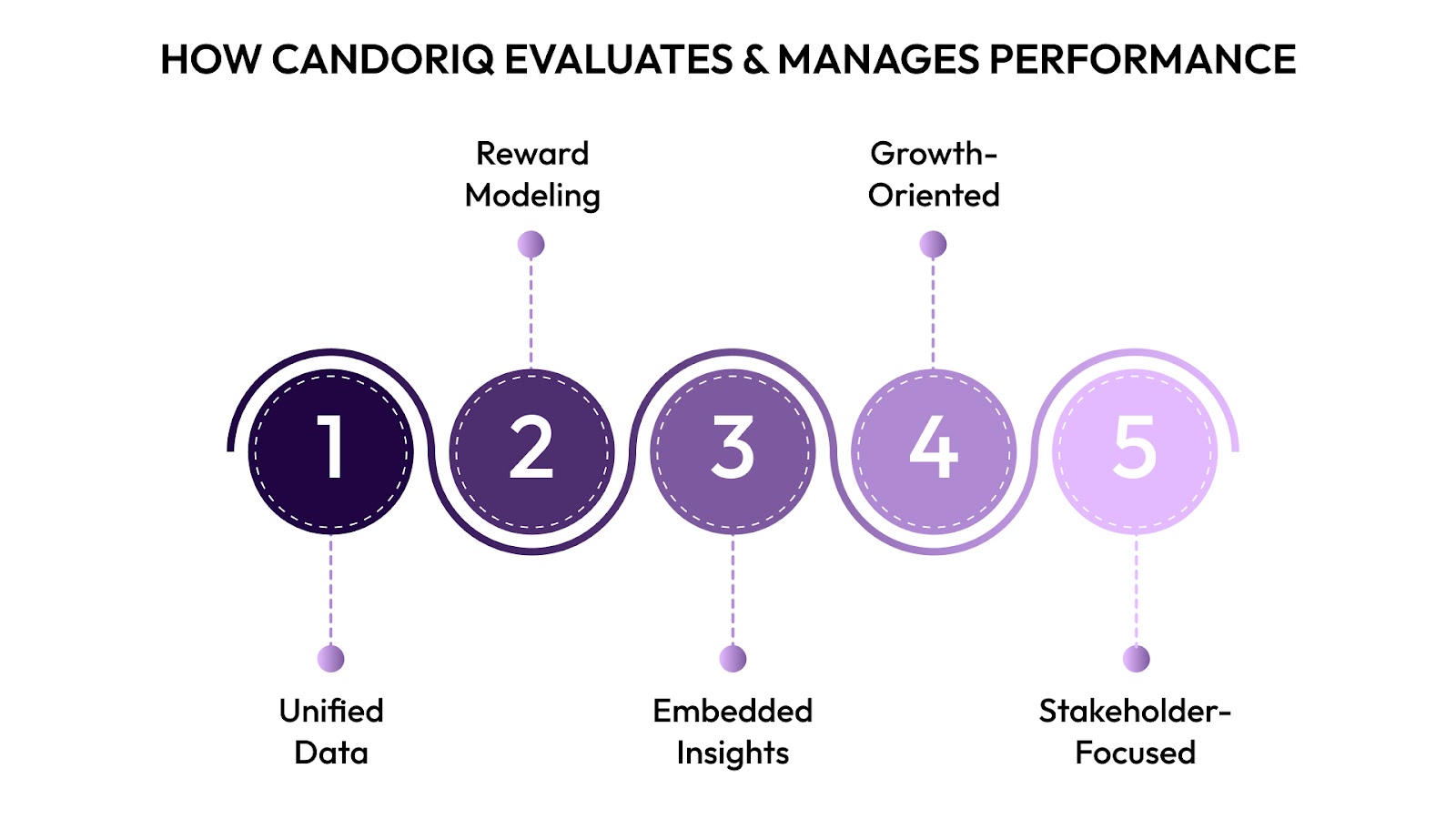
Managing performance at scale requires more than templates and checklists. Fast-growing teams need infrastructure that can support real-time decision-making, collaboration across departments, and consistent reward practices. That’s where CandorIQ comes in.
Here’s how it supports performance management from strategy to execution:
- Centralized Performance and Compensation Data: CandorIQ brings goal tracking, performance reviews, compensation plans, and equity refresh cycles into one system. This eliminates scattered documents and creates a single source of truth across HR, Finance, and leadership.
- Scenario Modeling for Reward Planning: From calibrating ratings to projecting the cost of promotions or equity grants, CandorIQ helps simulate different outcomes before decisions are made. This ensures reward plans stay fair, transparent, and aligned with budget constraints.
- Built-In Analytics for Actionable Insights: The platform automatically surfaces trends in performance ratings, promotion velocity, and review participation. This gives leaders an early view into gaps whether in process, fairness, or recognition.
- Designed for Modern, High-Growth Teams: CandorIQ is purpose-built for fast-scaling SaaS, fintech, e-commerce, and professional services companies managing hybrid workforces and lean HR ops. It adapts to complexity without adding more manual steps.
- Ideal for Strategic Stakeholders: Whether you're a CPO aligning performance frameworks, a CFO modeling compensation budgets, or an HRBP planning growth paths, CandorIQ gives you the visibility and structure needed to act decisively without relying on disconnected tools.
By replacing fragmented workflows with one intelligent system, CandorIQ transforms performance management from a reactive process into a strategic driver of talent, growth, and fairness.
Curious how it might work for your team? Request a tailored demo to see CandorIQ in action.

Final Word: Make Performance Count for Everyone
In fast-moving companies, you cannot afford to fly blind. Performance management needs to evolve from a reactive, backward-looking ritual to a forward-facing, always-on system.
When done right, it’s not just about evaluating people. It’s about investing in them. It’s about linking data to decisions, rewarding fairly, and building a company where growth is transparent and shared.
If you’re looking to level up your performance strategy, start with visibility. From there, structure, alignment, and trust will follow.
Want to stop guessing and start growing? Explore CandorIQ’s platform and move toward performance systems that actually work.
Frequently Asked Questions
Q: How often should performance reviews be conducted in fast-growing companies?
Ans: While annual reviews were once standard, they are no longer sufficient for fast-paced teams. Monthly or quarterly check-ins are more effective. They allow for real-time feedback, faster course correction, and stronger alignment with evolving goals.
Q: What’s the best way to connect performance to compensation decisions?
Ans: Start by creating a transparent rubric that links outcomes to rewards. Use consistent performance ratings across teams and combine them with business metrics. Platforms like CandorIQ help by modeling different compensation scenarios before rollout.
Q: Who should be involved in performance management?
Ans: It’s a shared responsibility. HR builds the framework, Finance aligns rewards with budgets, and managers execute day-to-day feedback. Collaboration among all three ensures fairness and consistency.
Q: How can we reduce bias in performance evaluations?
Ans: Use a mix of peer, manager, and cross-functional feedback. Standardize criteria across departments and regularly calibrate ratings. A centralized system that captures feedback from multiple sources can also highlight inconsistencies early.
Q: What metrics matter most when tracking performance?
Ans: Look at goal completion rates, retention by performance tier, internal mobility, and engagement in feedback cycles. These indicators give a fuller picture of what’s working and where to intervene.
Q: Why do most performance management systems fail to scale?
Ans: Many rely on scattered tools or manual tracking, which leads to inefficiencies and inconsistency. Without centralized data and a shared system, it becomes hard to align performance with decisions like promotions or equity distribution.
Q: Can a performance system also support DEI goals?
Ans: Yes. A well-structured system allows you to monitor performance, compensation, and promotion trends across demographics. This helps identify disparities and course-correct early to build a more equitable organization.


